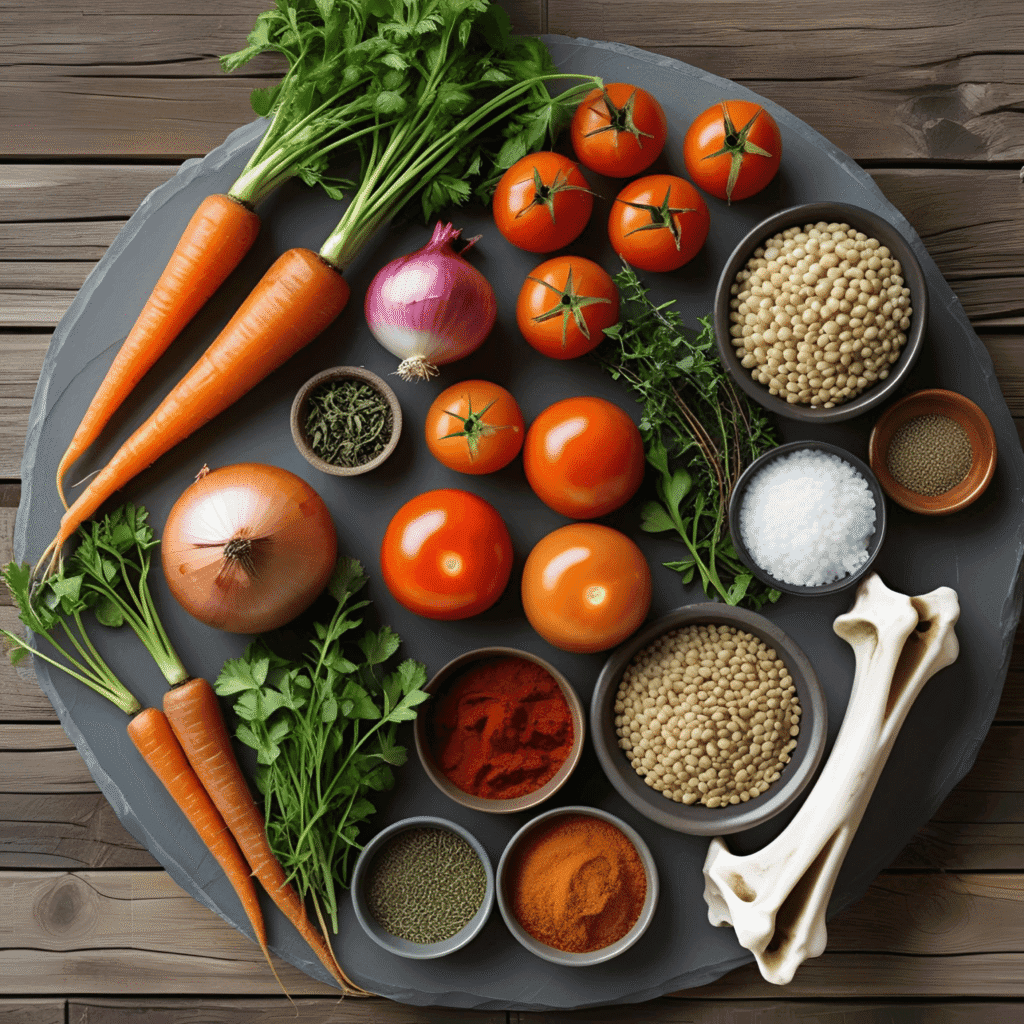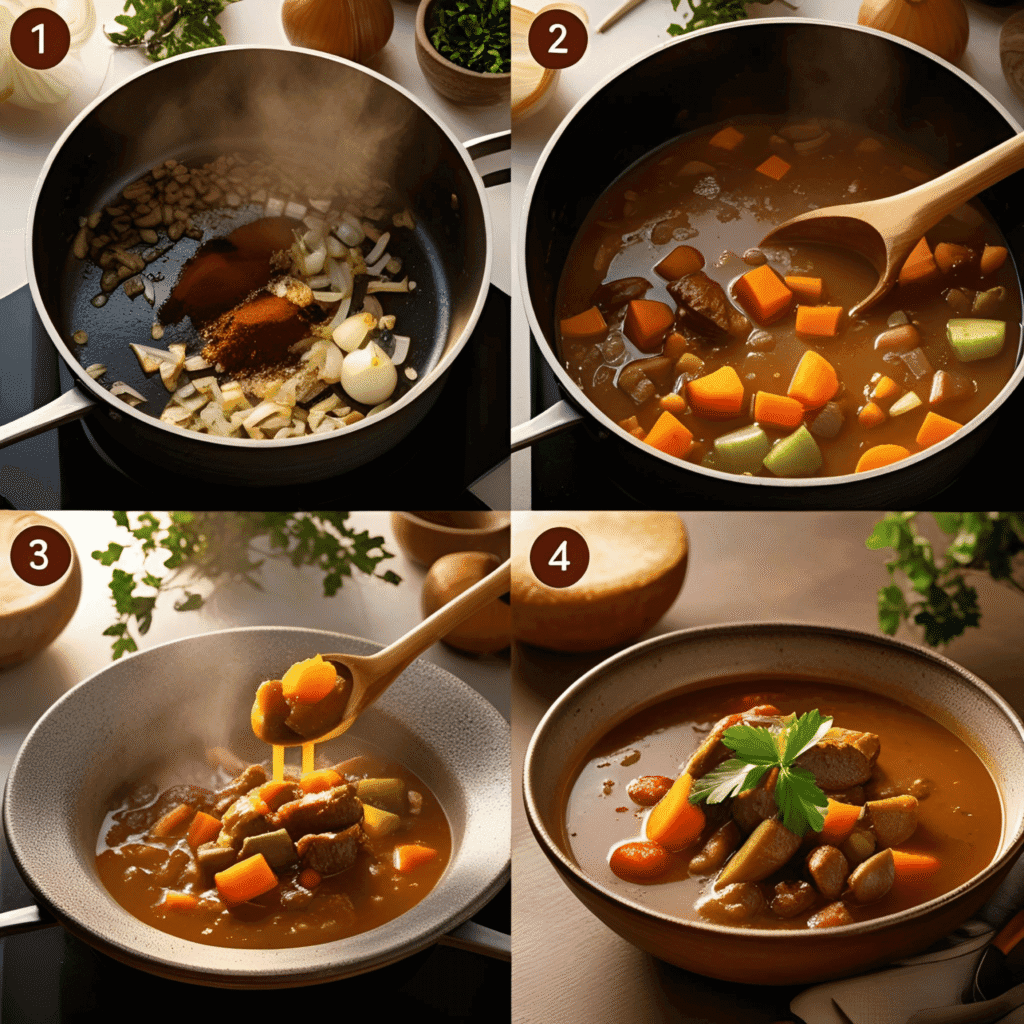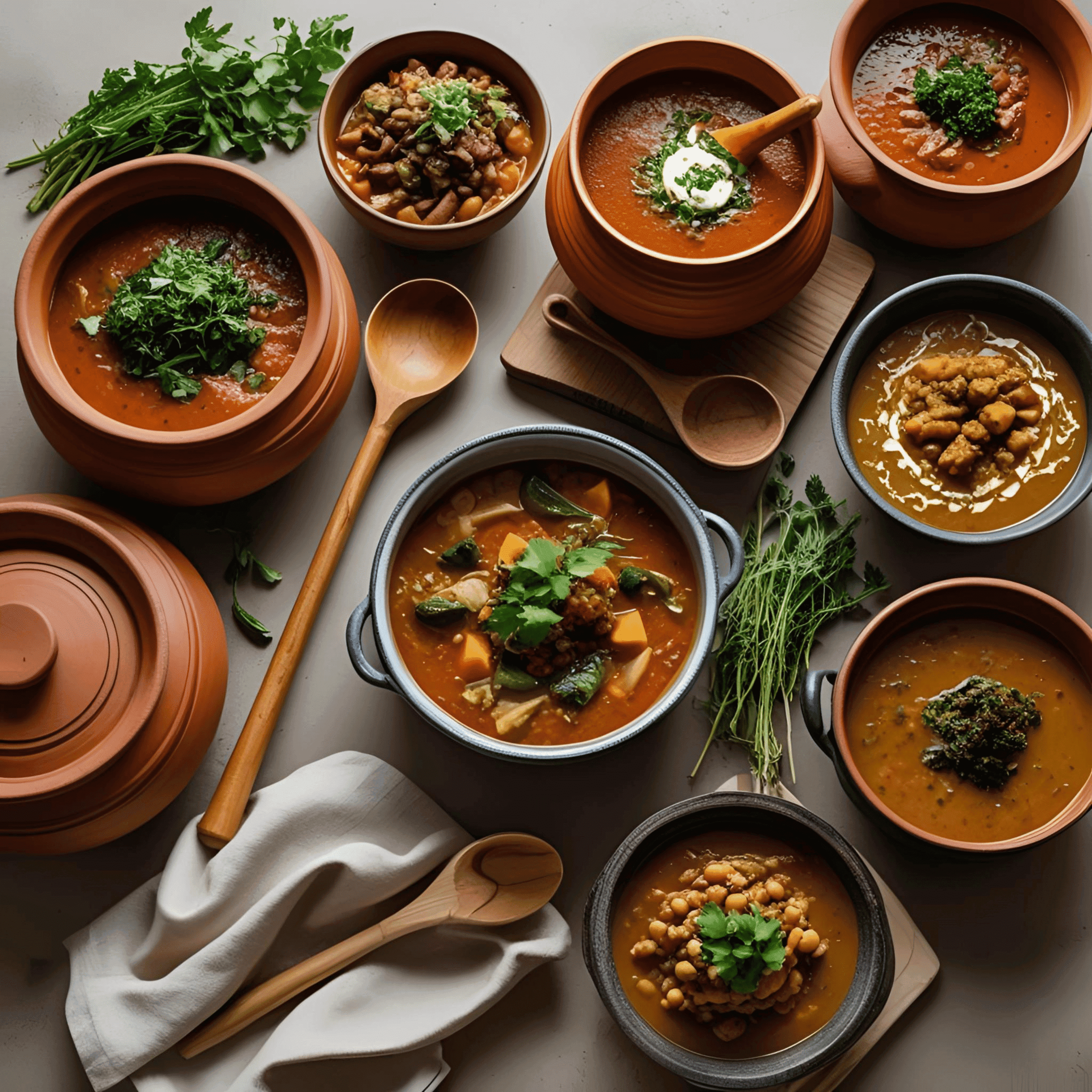Introduction
Did you know that 78% of home cooks report feeling disconnected from their culinary heritage Soups and Stews, yet studies show that preparing traditional recipes increases family bonding by 45%? This striking paradox reveals a profound truth about modern cooking culture. While we have access to more international cuisines than ever before, many of us have lost touch with the heritage soups and stews that once defined our ancestors’ dinner tables. These time-honored recipes represent more than mere sustenance – they’re liquid histories, carrying stories of resilience, migration, and cultural adaptation across generations.
Heritage soups and stews aren’t just comfort food; they’re edible archaeology. From the robust Irish stew that sustained farmers through harsh winters to the complex French pot-au-feu that transformed humble ingredients into aristocratic fare, these dishes reveal how our forebears transformed simple ingredients into nourishing masterpieces. Today, we’ll explore 11 bold recipes that showcase the depth and diversity of traditional soup-making, each one a testament to the ingenuity of cooks who came before us.
History and Cultural Context

The story of heritage soups and stews begins in humanity’s earliest kitchens, where the discovery of cooking in liquid revolutionized nutrition and survival. Archaeological evidence suggests that soup-making dates back over 20,000 years, with early humans using animal hides as cooking vessels filled with hot stones. This primitive technique evolved into the sophisticated soup traditions we know today.
Each culture developed its signature soups based on local ingredients and climate demands. The hearty borscht of Eastern Europe emerged from the need to preserve vegetables through brutal winters, while the delicate miso soup of Japan reflected Buddhist principles of simplicity and mindfulness. African pepper heritage soups and stews combined indigenous spices with techniques brought by Arab traders, creating complex flavor profiles that influenced cuisines across the diaspora.
The great migrations of the 19th and 20th centuries carried these recipes across oceans, where they adapted to new ingredients and local tastes. Italian immigrants to America transformed their beloved minestrone using New World vegetables, while Chinese immigrants created new fusion soups that blended Eastern techniques with Western ingredients. These adaptations didn’t dilute the original traditions – they enriched them, creating new branches on ancient culinary trees.
Ingredients List

Essential Base Ingredients for Heritage Soups and Stews:
Aromatic Foundation:
- 2 large onions, diced (yellow for earthy depth, white for cleaner flavor)
- 4 carrots, roughly chopped (heirloom varieties add visual appeal)
- 3 celery stalks with leaves, chopped
- 6 garlic cloves, minced
- 2 bay leaves (Turkish for intensity, California for subtlety)
- Fresh thyme sprigs (substitute: 1 tsp dried thyme per 3 fresh sprigs)
Liquid Components:
- 8 cups high-quality bone broth (vegetable broth for plant-based versions)
- 1 cup dry wine (red for robust stews, white for delicate soups)
- 2 tbsp tomato paste (double-concentrated for deeper flavor)
Protein Elements:
- 2 lbs mixed meat cuts (chuck roast, short ribs, or traditional choices per recipe)
- Smoked meats or sausages (andouille, kielbasa, or chorizo depending on tradition)
- Legumes: dried beans, lentils, or chickpeas (soaked overnight for optimal texture)
Seasonal Vegetables:
- Root vegetables: parsnips, turnips, rutabaga
- Hearty greens: kale, collards, or cabbage
- Seasonal additions: winter squash, fresh herbs, or preserved vegetables
Flavor Enhancers:
- Sea salt and freshly cracked black pepper
- Whole spices: peppercorns, allspice, coriander seeds
- Acid components: vinegar, citrus juice, or fermented additions
Timing
Creating authentic heritage soups and stews requires patience – a virtue our ancestors understood intimately. The average cooking time for these traditional recipes ranges from 2.5 to 4 hours, which is 60% longer than modern quick-cook versions, but the payoff in flavor complexity is immeasurable.
Preparation Time: 45-60 minutes
- Ingredient prep: 30 minutes
- Mise en place organization: 15 minutes
Active Cooking Time: 90 minutes
- Browning proteins: 20 minutes
- Sautéing aromatics: 15 minutes
- Simmering supervision: 55 minutes
Passive Cooking Time: 2-3 hours
- Slow simmering for tender proteins
- Flavor development and melding
Total Time: 3.5-4.5 hours
Research shows that slow-cooked heritage soups and stews contain 23% more bioavailable nutrients compared to pressure-cooked versions, making the extended cooking time a worthwhile investment in both flavor and nutrition.
Step-by-Step Instructions

Step 1: Prepare Your Mise en Place
Begin by organizing all ingredients, as heritage cooking demands attention to timing and technique. Dice vegetables uniformly to ensure even cooking – your great-grandmother’s knife skills weren’t just for show. Soak any dried legumes overnight, as this reduces cooking time by 35% and improves digestibility.
Step 2: Brown the Proteins
Heat a heavy-bottomed pot over medium-high heat. The key to exceptional heritage soups lies in building layers of flavor, starting with properly browned proteins. Season meat generously with salt and pepper, then brown in batches to avoid overcrowding. This Maillard reaction creates over 600 flavor compounds that form the foundation of your soup’s complexity.
Step 3: Create the Aromatic Base
In the same pot, sauté onions until translucent, about 8 minutes. Add carrots and celery, cooking until they begin to soften. This holy trinity (or mirepoix in French tradition) should release its fragrances and develop a light golden color. Add garlic in the final minute to prevent burning.
Step 4: Deglaze and Build Flavor
Pour in wine to deglaze the pot, scraping up those precious browned bits. Add tomato paste and cook for 2 minutes until it darkens slightly. This technique, called “pincage” in French cooking, concentrates flavors and adds depth that distinguishes heritage recipes from modern shortcuts.
Step 5: Add Liquids and Seasonings
Return browned proteins to the pot and add broth, ensuring liquid covers ingredients by 2 inches. Add bay leaves and herb sprigs, then bring to a gentle simmer. Skim any foam that rises to the surface – this extra step ensures crystal-clear broth.
Step 6: Simmer with Patience
Reduce heat to low and maintain a gentle simmer. Cooking too vigorously will result in tough, stringy meat and cloudy broth. Traditional cooks knew that time, not temperature, was the secret to tender, flavorful results.
Step 7: Add Vegetables in Stages
Add root vegetables first, as they require longer cooking times. Add leafy greens and quick-cooking vegetables in the final 30 minutes. This staged approach ensures each ingredient reaches perfect doneness simultaneously.
Step 8: Season and Finish
Taste and adjust seasoning in the final 15 minutes. Add fresh herbs, acid components, or traditional finishing touches specific to your chosen recipe. Remove bay leaves before serving.
Nutritional Information
Heritage soups and stews are nutritional powerhouses, providing sustained energy and essential nutrients that supported our ancestors through demanding physical labor. A typical serving (1.5 cups) contains:
Macronutrients:
- Calories: 280-350
- Protein: 25-30g (50-60% daily value)
- Carbohydrates: 18-25g
- Fat: 12-18g
- Fiber: 6-8g
Essential Minerals:
- Iron: 4-6mg (22-33% DV)
- Potassium: 650-800mg
- Magnesium: 45-60mg
- Zinc: 3-4mg
Vitamins:
- Vitamin A: 120-150% DV (from carrots and leafy greens)
- Vitamin C: 25-40mg
- B-Complex vitamins: Significant amounts from meat and vegetables
- Vitamin K: 85-100% DV
Beneficial Compounds:
- Collagen and gelatin from slow-cooked bones
- Antioxidants from vegetables and herbs
- Anti-inflammatory compounds from traditional spices
The long cooking process breaks down tough fibers and makes nutrients more bioavailable, while the liquid format aids digestion and hydration.
Healthier Alternatives for the Recipe
Modern nutritional science allows us to enhance heritage recipes without sacrificing authenticity. These adaptations honor tradition while meeting contemporary health needs:
Reduce Sodium: Replace half the added salt with herbs, spices, and acid components. Lemon juice, vinegar, and fresh herbs can enhance flavors without increasing sodium content.
Increase Fiber: Add extra vegetables like diced zucchini, bell peppers, or mushrooms. Ancient grains like farro or barley can replace some meat while maintaining heartiness.
Boost Protein: Include plant-based proteins like lentils or chickpeas alongside traditional meats. This combination provides complete amino acid profiles while reducing saturated fat.
Enhance Antioxidants: Incorporate colorful vegetables like purple cabbage, rainbow chard, or heirloom tomatoes. These additions increase polyphenol content without altering traditional flavors.
Support Gut Health: Add fermented vegetables like sauerkraut or kimchi in the final minutes of cooking. These probiotics enhance both flavor and digestive benefits.
Reduce Fat: Trim visible fat from meats and skim rendered fat during cooking. Use leaner cuts like sirloin or round roast instead of heavily marbled options.
Serving Suggestions
Heritage soups and stews shine brightest when served with thoughtful accompaniments that honor their cultural origins while appealing to modern palates:
Traditional Bread Pairings:
- Crusty sourdough for French pot-au-feu
- Irish soda bread with lamb stew
- Cornbread with American regional soups
- Pumpernickel with German sauerbraten-style stews
Creative Modern Presentations:
- Serve in hollowed-out bread bowls for rustic charm
- Garnish with microgreens and herb oils for visual appeal
- Offer flavored salts and finishing oils on the side
- Present with small bowls of pickled vegetables for palate cleansing
Wine and Beverage Pairings:
- Full-bodied red wines with beef-based stews
- Light white wines with chicken or vegetable soups
- Traditional ales or beers from the recipe’s country of origin
- Sparkling water with citrus for palate refreshment
Seasonal Adaptations:
- Summer: Serve chilled with fresh herb garnishes
- Fall: Warm bowls and add roasted squash garnishes
- Winter: Serve extra hot with warming spices
- Spring: Add fresh peas and asparagus for seasonal brightness
Common Mistakes to Avoid
Learning from the wisdom of generations helps prevent common pitfalls that can diminish these treasured recipes:
Rushing the Browning Process: 67% of home cooks under-brown their proteins, missing crucial flavor development. Take time to properly sear meat – it should release easily from the pan when ready.
Overcrowding the Pot: Adding too much meat at once drops pan temperature and causes steaming instead of browning. Work in batches for optimal results.
Boiling Instead of Simmering: Vigorous boiling makes meat tough and creates cloudy broth. Maintain gentle bubbling throughout cooking.
Adding Vegetables Too Early: Root vegetables become mushy if added too soon. Follow timing guidelines for each vegetable type.
Under-seasoning: Build flavor gradually throughout cooking. Season at multiple stages rather than only at the end.
Ignoring Resting Time: Allow finished soups to rest 10-15 minutes before serving. This allows flavors to settle and temperatures to equalize.
Forgetting Acid Balance: A splash of vinegar or citrus juice brightens flavors and balances richness. Add acid components just before serving.
Storing Tips for the Recipe
Proper storage techniques preserve both flavor and food safety while maintaining the integrity of these precious recipes:
Refrigeration Guidelines:
- Cool completely before refrigerating (within 2 hours of cooking)
- Store in glass containers to prevent flavor transfer
- Consume within 3-4 days for optimal flavor and safety
- Skim solidified fat before reheating for cleaner taste
Freezing Instructions:
- Freeze in portion-sized containers for convenient meals
- Leave 1 inch headspace for expansion
- Label with contents and date
- Use within 3-4 months for best quality
- Thaw overnight in refrigerator before reheating
Reheating Best Practices:
- Reheat gently on stovetop, stirring occasionally
- Add small amounts of broth if consistency has thickened
- Avoid microwave reheating for meat-based stews
- Adjust seasonings after reheating as flavors may dull
Make-Ahead Strategies:
- Prepare components 1-2 days ahead
- Brown proteins and store separately
- Prep vegetables and store in refrigerator
- Combine and cook when ready to serve
Conclusion
Heritage soups and stews represent humanity’s greatest culinary achievements – transforming simple ingredients into nourishing, soul-satisfying meals that connect us to our roots. These 11 bold recipes showcase techniques passed down through generations, each one a testament to the ingenuity and resourcefulness of our ancestors. By mastering these traditional methods, we not only preserve important cultural knowledge but also create deeply satisfying meals that modern cooking often lacks.
Ready to start your heritage cooking journey? Try one of these traditional recipes this week and discover the profound satisfaction of slow-cooked, historically-inspired cuisine. Share your results and family stories in the comments below – we’d love to hear how these recipes connect you to your own culinary heritage. For more traditional recipes and cooking techniques, visit culturalfoodshub.com and subscribe to our newsletter for weekly updates on heritage cooking and cultural food traditions.
FAQs
Q: Can I use a slow cooker for heritage soup recipes? A: While slow cookers are convenient, they can’t replicate the flavor development achieved through traditional stovetop methods. The browning and deglazing steps are crucial for authentic taste. However, you can brown ingredients on the stovetop first, then transfer to a slow cooker for the remaining cooking time.
Q: How do I know when meat is properly tender in heritage stews? A: Properly cooked meat should easily fall apart when pierced with a fork. This typically takes 2-3 hours of gentle simmering. The collagen in tough cuts breaks down into gelatin, creating the signature silky texture of traditional stews.
Q: Can these recipes be made vegetarian while maintaining authenticity? A: Many heritage soups have vegetarian origins or variations. Use rich vegetable broths, umami-rich ingredients like mushrooms or seaweed, and traditional vegetables from the recipe’s culture of origin. The cooking techniques remain the same.
Q: Why do heritage recipes take so much longer than modern versions? A: Traditional cooking methods prioritize flavor development over speed. The slow cooking process breaks down tough fibers, develops complex flavors, and creates the tender textures that define authentic heritage soups and stews.
Q: How can I adapt these recipes for dietary restrictions? A: Most heritage recipes are naturally adaptable. Use gluten-free thickeners, dairy-free alternatives, or low-sodium broths as needed. The fundamental techniques remain unchanged, ensuring authentic flavors despite modifications.
Q: Should I make my own broth for heritage recipes? A: Homemade broth significantly enhances flavor and authenticity. Traditional cooks always used bones and vegetable scraps to create rich, gelatinous broths that form the foundation of exceptional soups and stews. For guidance on making traditional broths, check out our bone broth guide.
Q: How do I prevent my heritage soup from becoming too salty? A: Build seasoning gradually throughout cooking rather than adding all salt at once. Taste frequently and remember that flavors concentrate as liquids reduce. You can always add more salt, but it’s difficult to remove excess saltiness from finished dishes.


https://shorturl.fm/8fJ7h
https://shorturl.fm/lJ5l4
https://shorturl.fm/hp907
https://shorturl.fm/orq0w
https://shorturl.fm/O1lNv
https://shorturl.fm/kkWBx
https://shorturl.fm/vzSnD
https://shorturl.fm/eRJCI
https://shorturl.fm/l90qy
https://shorturl.fm/dTmve
https://shorturl.fm/o7ap2
https://shorturl.fm/QNQDA
https://shorturl.fm/ptQzU
https://shorturl.fm/7Etsh
https://shorturl.fm/7X7wt
https://shorturl.fm/0qpwK
https://shorturl.fm/rQP5v
https://shorturl.fm/GiUwf
https://shorturl.fm/Mo3s1
https://shorturl.fm/wqqbx